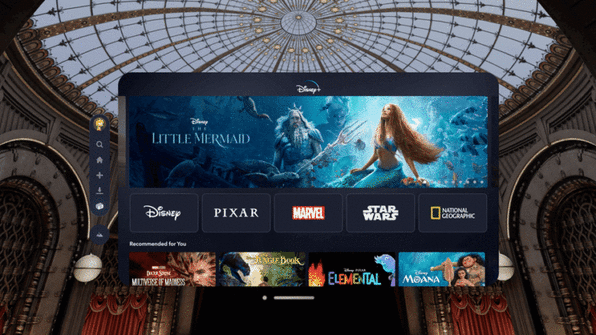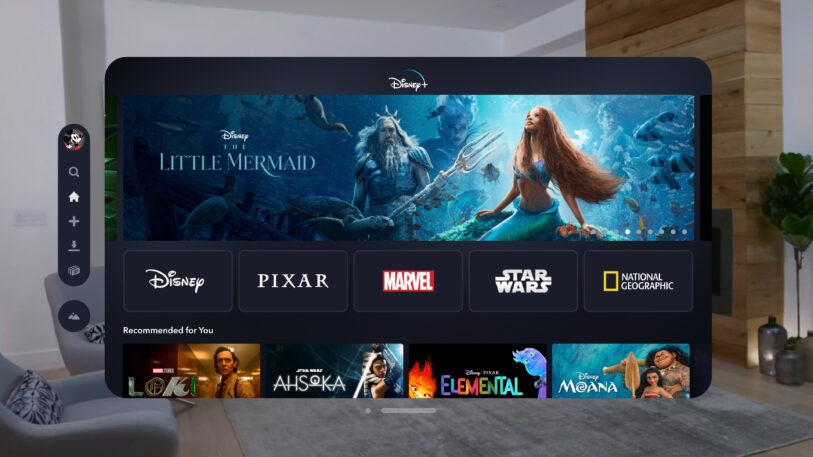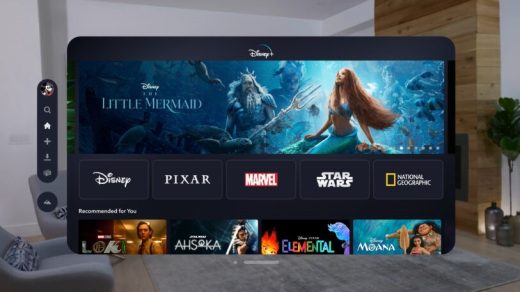Inside Disney’s big bet on Apple Vision Pro and spatial computing
Last June, when Apple streamed the unveiling of its Apple Vision Pro “spatial computing headset” during its WWDC conference, a special guest was part of the festivities: Disney CEO Bob Iger. His appearance wasn’t exactly a shocker. After all, the two companies have had a famously friendly relationship for many years. Moreover, Disney prides itself on being an early adopter of new technologies—a trait dating to its earliest days, when Walt Disney himself was quick to embrace cinematic innovations such as sound and color.
During the stream, Iger introduced a video vouching for Disney’s support of the Vision Pro. It featured several spatial-computing experiences that Apple’s headset might theoretically enable, from an at-home version of Disney World’s Main Street Electrical Parade to a basketball game’s action recreated in a 3D hoop-to-hoop view. But there was also one piece of concrete news: the Disney+ streaming service would be available on Vision Pro from day one.
With its twin 4K displays, precision eye tracking, hand-gesture input, and 3D VisionOS environment, it’s obvious that Vision Pro is the result of years of effort on Apple’s part. What’s less apparent is that the company also began helping Disney plan its presence on the headset long before most people knew it as anything more than an intriguing rumor.
“We’ve been working for a few years together pretty deeply on this,” says Jamie Voris, CTO of The Walt Disney Studios. “Given the nature of the product and the partnership and everything, it’s been very secretive, even within our own company.”

As explained in a 2022 article by The Information’s Wayne Ma, the roots of Apple’s headset project date to 2015, when the company hired a Dolby technology executive named Mike Rockwell. Before long, he was quietly investigating what an Apple augmented-reality device might look like. And eventually, Voris was one of the outsiders allowed into the cone of silence.
“Mike and I have known each other for a long, long time, across different jobs, and have had lots of conversations over the years,” he explains. “When he went to Apple, I had no idea what he was working on. But we would have conversations where we would both talk about how excited we were about mixed reality and spatial computing. And at a certain point, we kind of started to triangulate on, ‘Hmm, maybe there’s a reason to have a deeper conversation here.’ Out of that grew this partnership.”
Disney’s enthusiasm for the $3,499 headset is hardly shared by every third-party developer. The relatively small number of apps available in native form at launch—Apple says it’s “more than 600?—suggests that many developers are taking a wait-and-see approach. Among major streaming services, Disney+, Max, and Pluto TV are ready with native versions. Others, such as Amazon Prime Video, Paramount+, and Peacock, have iPad apps that can run on the headset, a decent stopgap. Meanwhile, Netflix, Spotify, and YouTube are accessible only via the Vision Pro’s Safari browser, the least user-friendly option.
To Disney, erring on the side of taking Vision Pro seriously wasn’t just about a short-term business calculation. Instead, it saw glimmers of a new entertainment medium. “The reality is, this is just the starting line for these types of devices and experiences,” says Disney Entertainment & ESPN president and CTO Aaron LaBerge. “We’re a storytelling company, and this is a platform that allows us to tell stories in a different way. That’s why we were so excited about it.”

So, what does Disney get out of retooling Disney+ for VisionOS in the short term? For one thing, it was able to give the app a true spatial interface, with a strip of icons that floats to the left of the main window. It also added a prominent space dedicated to Disney+’s library of 40 3D movies, a copious collection of entertainment that’s at home on the Vision Pro in ways 2D content could never be.
But by far the most interesting aspect of Disney+ on Apple Vision Pro is immersing yourself in any of four virtual environments. Taking advantage of the Vision Pro’s ability to trick your eyes into thinking they’re seeing a theater-sized screen, they wrap whatever you’re watching in an old-fashioned movie palace (inspired by Hollywood’s Disney-owned El Capitan), Monsters Inc’s Scare Floor, the Avengers’ Manhattan headquarters, or Luke Skywalker’s landspeeder as seen on his home planet of Tatooine.
Each of these virtual settings surrounds you in 360 degrees of obsessively rendered detail, showing off the Vision Pro’s ability to create a 3D effect that is, at times, uncannily convincing. (For a split-second, I mistook a takeout box in the Avengers HQ for one in my own actual living room.) When you press play to watch a movie or show, the surroundings dim as they would in a real theater, which is probably just as well, given the temptation to sit there and gawk.
For Disney’s techies, coding the Disney+ app involved both familiar processes and new challenges, and took the better part of a year. Even brief exposure to native Vision Pro apps will tell you that they’re close kin to those designed for the iPad, which gave the company a healthy head start on getting a spatial version of the streaming service up and running. “If you’re building apps in Swift for the iPad, it’s a no-brainer,” says LaBerge. “It all translates over and is super-easy to do.”
To construct the immersive viewing environments, Disney used an Apple tool called Reality Composer Pro. That software allows for the creation of 3D imagery in a format called Universal Scene Description. And in a nifty bit of proof of how deep the Apple-Disney collaboration runs, USD happens to have originated at Disney’s own Pixar studio. (It’s since become an industry standard supported by other big players such as Adobe, Autodesk, and Nvidia.)
More to come
Ultimately, the viewing environments are just a delightful, unexpected cherry on top of Disney+’s Apple Vision Pro experience rather than a new form of entertainment unto themselves. At this early point in the headset’s existence, that might be enough—or even the whole point. As LaBerge puts it, “It’s a very simple implementation in some ways, but it will also blow you away.”
Given Disney’s bottomless reservoir of intellectual property, additional ones feel inevitable. Voris brings up National Geographic as one likely source of additional fodder: “It was a little bit of a surprise to me how much people have loved the immersive environments,” he admits.
Still, the company has only begun to live up to the aspirational bar Iger set during Vision Pro launch, when he called the headset “a platform [that] will allow us to bring Disney to our fans in ways that were previously impossible” and spoke of creating “deeply personal experiences.” The one other project that Voris confirms is definitely in the works is a Vision Pro app based on the Disney+ alternate-Marvel-realities show What If…?. Teased at the end of Disney’s WWDC video, “It’s going to be the first real mixed-reality, emotional, immersive story that people have ever experienced,” he says.
Without disclosing any specifics, Voris and LaBerge told me much more is on the way. “This product has touched every part of our company, from the studios to the teams that manage our streaming services to our mobile developers,” says LaBerge. “Even our teams at the parks have been involved in the things that we’re doing.” Behind the scenes, he adds, the headset is also “going to change our entire production and post-production pipeline. It’s going to change how we make content, how we operate our environments. It’s a big deal.”
Even at Disney, plenty of people are still just getting acquainted with the Vision Pro, a device that can’t really be assessed until you’ve tried it for yourself: “I was demoing [it] for somebody this morning, and literally, his jaw was open the entire time,” says Voris.
But by the time the company is thoroughly adept at telling stories in spatial computing, it could be a much bigger opportunity. Or at least Voris has sky-high expectations, though he acknowledges that people inclined to see the Vision Pro as “bulky and expensive” aren’t wrong.
“When we can get it to a price point and form factor that are mass market,” he says, “everybody in the world is going to want this.”
(10)


